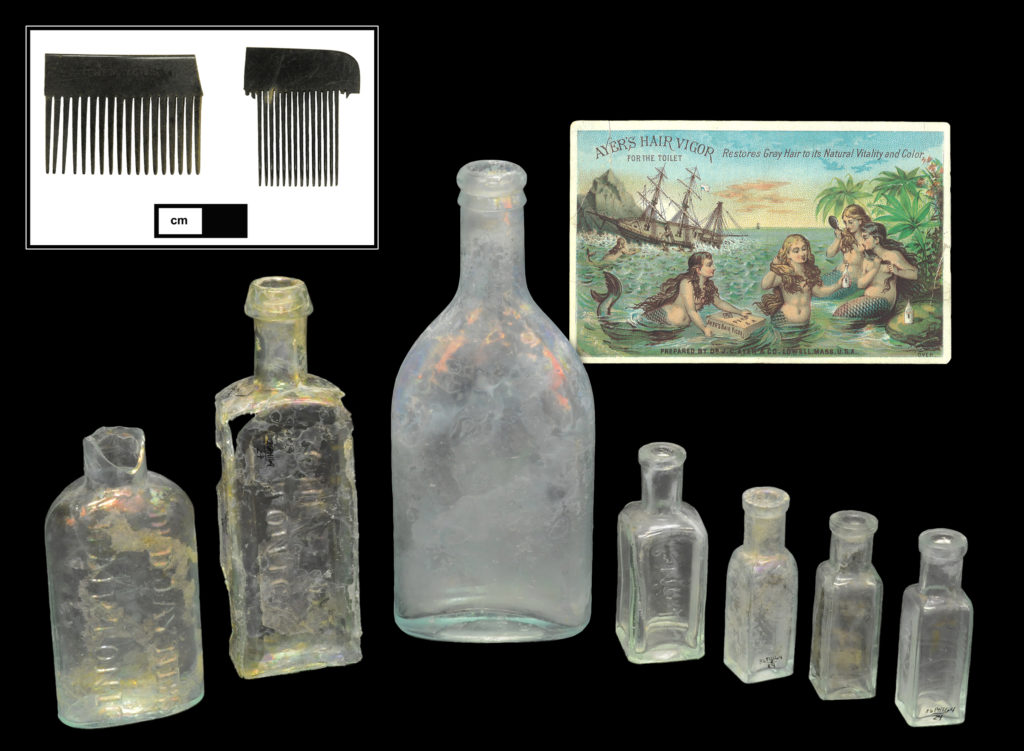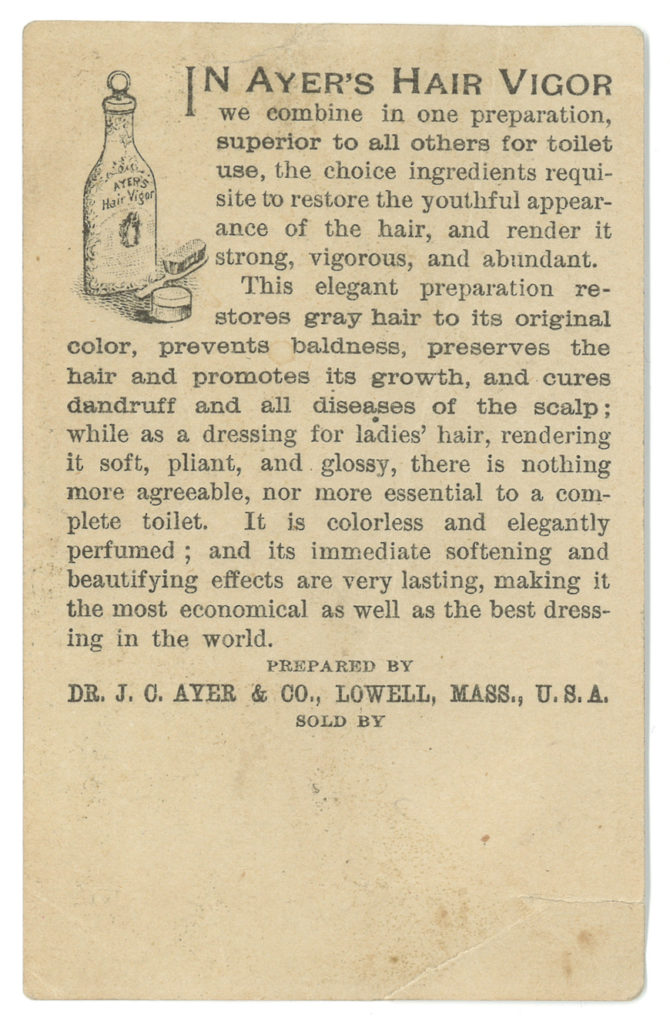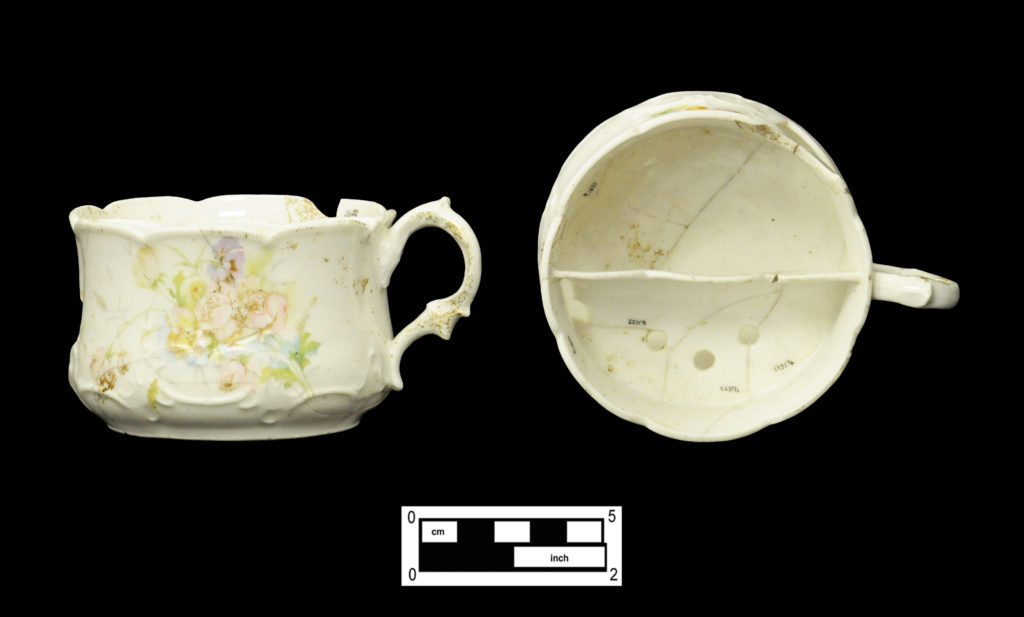The growing emphasis on personal appearance and fashion throughout the nineteenth century resulted in the introduction of a variety of hair products. Advertisements claimed these products covered gray or thinning locks and restored hair in cases of baldness.

Hair Products
Among the assorted bottles and vials excavated from this feature were nine bottles with embossed marks identifying five different hair treatments. The earliest of these bottles, featuring an oval form and blow pipe/open pontil scar on its base, is embossed, “DR. D. JAYNE’S / HAIR TONIC // PHILAD.A” (4A-G-0052). Dr. Jayne’s original product seems to have been “Alibert’s Oleaginous Hair Tonic,” which was probably sold as early as 1838. It was not until late January 1840 that Jayne’s product was first advertised merely as “Jayne’s Hair Tonic” or “the ‘Hair Tonic’ sold by Dr. Jayne.” 1 Based on this bottle’s attributes and embossing (earlier Alibert’s Oleaginous Hair Tonic bottles do exist), it was thus likely made between circa 1840 and the mid-1860s (4A-G-0052). This hair tonic was just one of several products Dr. David Jayne & Sons offered at their large drug business once located on Chestnut Street in Philadelphia.
Fragments of two bottles from this feature are embossed with the rather exotic sounding name “Cheveux Tonic” (4A-G-0298; 4A-G-0356). The narrow, side panels of the more complete bottle were marked with the name “G. Cane” on one side and the place of manufacture “Trenton, NJ” on the other. In 1851, Gustavus Cane was operating the Star Hair-Dressing and Shaving Saloon at 7 East State Street in Trenton. 2 An advertisement in the Trenton State Gazette from July of that year details the services the establishment offered and describes Cane’s tonic: “At his Saloon, may also be procured G. Cane’s Cheveux Tonic, a vegetable liquid, of fine fragrance, giving to the hair a soft and glossy hue, preventing its turning grey or coming out, and effectually removing Dandruff—prepared only by him.” 3 Cane continued to advertise his hair tonic in the Trenton newspaper through 1855. 4 He had left the region by 1868, when his name appears on the voter registration roles in San Francisco, California. 5
The name “AYER,” molded into the base of a flask-like bottle, helped to identify it as the container for Ayer’s Hair Vigor (4A-G-0071). A large paper label once encased the bottle, detailing the uses of this product originally sold by James C. Ayer & Co. of Lowell, Massachusetts. While Ayer’s Hair Vigor was advertised from the late 1860s through the 1920s, this particular bottle likely dates between circa 1875 and 1890, based on its manufacturing characteristics. The recovered example, with its post-bottom molded base and tooled finish, represents one of the earliest versions of this bottle, probably made during the crossover from the product’s first containers (with post-bottom bases and applied finishes, likely circulated 1867–circa 1885) and the second incarnation of these bottles (with tooled finishes and cup-molded bases, circa 1885–circa 1900). 6

Contemporary late-nineteenth-century trade cards advertised the many proclaimed benefits of this product, and specifically how it “restores gray hair to its original color, prevents baldness, preserves the hair and promotes its growth, and cures dandruff and all diseases of the scalp.” In some of their advertisements, Ayer’s was also promoted as “a dressing for ladies’ hair”—a statement that suggests it was primarily marketed to men.
Four small bottles of J. Hambleton & Son hair dye were recovered from this shaft feature—one was embossed “No. 1,” while each of the other three were marked “No. 2” (4A-G-0017; 4A-G-0006; 4A-G-0007; 4A-G-0037). The No. 1 and 2 bottles were usually packaged together, so that bottle No. 1 was applied to the hair first, followed by No. 2. Philadelphia perfumers Job Hambleton and his son William first produced Hambleton’s Hair Stain, which continued to be sold through the early years of the twentieth century. In 1860, Hambleton’s was advertised as “best article in use for coloring the hair and whiskers a natural black or brown; does not fade or wash out.” 7
Testing was conducted on several hair products in 1878 and the results were published in an article entitled “Dangerous Cosmetics.” The test results placed Hambleton’s in the category of “unharmful hair dyes” and showed that bottle “No 1” contained a “yellowish-brown liquid” that was composed of “pyrogallic acid, with excess of alcohol.” The test revealed bottle “No 2” contained an “ammoniacal solution of argentic nitrate.” 8 The four Hambleton bottles recovered from this feature probably date between 1880 and the turn of the century. The presence of three bottles marked No. 2 suggests repeated use of the product or use of the product by multiple family members.
Fragments from a single yellow-amber paneled bottle bear the partial embossing, “…C. GLOVE… / …RIAL MANGE C… / …OMS RIVER N.J.” (4A-G-0354). This bottle once contained Henry Clay Glover’s Imperial Mange Cure, a treatment for a skin disease most common on domestic animals, but also occasionally found on humans. Indeed, while earlier advertisements described that Glover’s product was “warranted to cure all kinds and conditions of mange or skin diseases of any nature in dogs or cattle,” 9 by the early twentieth century, it was also advertised for “falling hair and dandruff.” 10 Glover, a veterinarian, partnered with Toms River, New Jersey, pharmacist Charles B. Mathis and began producing Glover’s Mange Cure in Mathis’ pharmacy in 1876. 11 While Glover’s Mange Cure was manufactured for over a century, the bottle represented by the two fragments recovered from this privy shaft likely dates sometime between 1876 and the early twentieth century. Whether the residents of 1018 Palmer used it to restore the bald spots on dogs and horses, or purchased it with a family member’s falling hair in mind, this bottle adds to the wide range of hair care products the Cramp and Bumm families kept at home.
Hair Accessories
Small fragments from two hard rubber combs were recovered from the feature behind 1018 Palmer (Cat # 4.29.60; 4.31.108). One of these fragments is straight sided and would have been used merely to comb and style the hair 12; the second comb is slightly curved, and was likely used by a girl or woman while putting their hair up in a specific style. This curved version also bears the incomplete mark, “…ARS PATENT MAY 6 1851.” In 1851, Charles Goodyear patented a way to make hard rubber through a process known as vulcanization, and shortly thereafter, in 1854, the India Hard Rubber Comb Company, licensed by Goodyear, began producing combs in New York. 13 Goodyears Rubber-Packing & Belting Company, the Philadelphia warehouse of the New York Belting and Packing Company, operated on Chestnut Street by 1856, and a circa-1856 chromolithograph depicting the shop advertised “Belting, Packing, Hose, Clothing, Druggist Articles, &c.” 14

Shaving Cup
When viewed from the side, this dainty-looking porcelain cup—decorated with a fancy handle, molded scrolls, and floral decals—could easily be mistaken for a teacup (4A-C-0030). Looking inside the vessel reveals that the upper portion is divided nearly in half by a ledge or shelf. The bottom of this shelf has several drain holes that define its function as a shaving cup. The shelf provided a space to lather up the shaving brush, while allowing any excess water to drain away from the soap back into the bottom of the cup. The base of this cup is marked with a molded edelweiss-like flower—possibly some form of maker’s mark, though it is currently unidentified.
Possible Hair Care Bottles
Vanzandt & Pollock Bottle
A relatively plain, colorless, ball-neck panel bottle recovered from behind 1018 Palmer Street features three indented panels with rounded, chamfered corners and a flat, front-label panel (4A-G-0157). The bottle features a cup-molded base and what seems to be an early tooled finish. The only embossing on the bottle appears at the bottom of the largest indented panel and reads merely, “V & P / PHILA.” Intensive directory research revealed that this bottle was likely made for, and sold by, Vanzandt & Pollock, a relatively short-lived perfumery partnership that was in business between 1867 and 1874. 15 James K. M. Vanzandt and William C. Pollock operated their business at 604 Arch Street for the large majority of its existence, and though the company was interchangeably listed as “druggists” and “perfumers” in the directories, contemporary advertisements indicate that they focused on toiletries. Indeed, an advertisement taken out by the company in an 1872 publication reads:
Choice Perfumery. / VANZANDT & POLLOCK, / PHILADELPHIA, / Importers of Pure Essential Oils, etc., / AND MANUFACTURERS OF / FINE PERFUMERY / EMBRACING A GREAT VARIETY OF / Toilet Extracts, Colognes, Toilet Waters, / Pomades, Oils, Cosmetiques, &c. / TO WHICH ARE BEING CONSTANTLY ADDED / NEW AND DESIRABLE STYLES. 16
Despite the company’s short period of existence, their products do seem to have reached well outside of Philadelphia, including small town shops in the Reconstruction South. A. A. Clisby, a diversified dealer in “Drugs, Medicines, Chemicals, Paints, Oils, Varnishes, Dye Stuffs, Window Glass, Putty, Paint Brushes, Sash Tools, Stationery, Toilet Articles, Perfumery, Superior Wines and Liquors of Every Grade, Fine Tobacco, Segars, &c.” in Edgefield, South Carolina, apparently stocked Vanzandt & Pollock toiletries. 17 In April 1873, Clisby advertised the arrival of “3 Dozen Vanzandt & Pollock’s Florida Water, the best and Cheapest perfume.” 18
While it cannot be determined what specific product this bottle once held, it almost certainly contained some form of toilet water or hair oil and, given the tight range for the Vanzandt & Pollock partnership, likely was purchased and used by a member of the Cramp family at 1018 Palmer Street.
Hover Bottles
Three small rectangular bottles recovered from this shaft feature are nearly identical, all embossed, “HOVER / PHILADA” (4A-G-0327, 4A-G-0276, 4A-G-0361). All three bottles feature flared finishes and blowpipe/open pontil scars on their bases. Two slightly different molds are represented by these bottles, differentiated by size variations in the last “A” of “PHILADA.”
Joseph E. Hover, an ink manufacturer in Philadelphia, was in business from the early 1840s to the mid-1880s, though the bottles from this shaft feature likely date from the 1850s. While Hover was a prominent ink supplier, he also began marketing china glue and hair dyes by the late 1840s and early 1850s; therefore, it is difficult to determine the original use for these small bottles. 19 Contemporary bottles of similar size and shape did typically contain hair products, however, and Tod Von Mechow, an authority on Hover bottles, has not only identified these three recovered bottles as previously undocumented variants, but also considers them hair bottles. 20
The presence and variety of hair products in this domestic deposit reveal that some of the members of the household were enticed to try several of the available products. It is interesting to note that the majority of these treatments were produced locally and that newspaper advertising seemed geared toward men, while trade cards often depicted women. These preparations and concoctions are the predecessors of the many hair care products marketed today.
References
- “Jayne’s Hair Tonic” advertisement, Public Ledger, January 21, 1840, p. 3, Newspapers.com, subscription database accessed February 2017, http://www.newspapers.com. ↩
- “G. Cane’s” advertisement, Trenton State Gazette, July 19, 1851, p. 3, Genealogy Bank, subscription database accessed January 2017, http://www.genealogybank.com. ↩
- “G. Cane’s” advertisement, Trenton State Gazette, July 19 1851, p. 3. ↩
- “Professor G. Cane’s” advertisement, Trenton State Gazette, February 15, 1855, p. 4, Genealogy Bank, subscription database accessed January 2017, http://www.genealogybank.com. ↩
- “California Great Registers, 1866–1910,” database accessed January 2017, https://familysearch.org, entry for Gustavus Cane, Voter Registration, September 3, 1868. ↩
- Bill Lindsey, “Hair Products,” Historic Glass Bottle Identification & Information Website, accessed October 2016, https://sha.org/bottle/household.htm#Hairproducts. ↩
- “Hambleton’s Hair Stain” advertisement, Public Ledger, March 31, 1860, p. 1, Newspapers.com, subscription database accessed January 2017, http://www.newspapers.com. ↩
- M. Benjamin, “Dangerous Cosmetics,” New Remedies: An Illustrated Monthly Trade Journal of Materia Medica, Pharmacy and Therapeutics VII: 324–326, ed. Fred’k A. Castle and Charles Rice, https://books.google.com/books?id=4V-ry9CtpOEC&pg=PA197&lpg=PA197&dq=New+Remedies+1878&source=bl&ots=arzKyUowKR&sig=0Jg9C-JzWRcEVHITefjdAPZ9dTQ&hl=en&sa=X&ved=0ahUKEwiJoe_r5_bPAhWIwiYKHYK1BbEQ6AEIHjAB#v=onepage&q=New%20Remedies%201878&f=false. ↩
- “Merciful Man is Merciful to his Beast” advertisement, The Evening Journal (Asheville, North Carolina), July 13, 1889, p. 1, Newspapers.com, subscription database accessed February 2017, http://www.newspapers.com. ↩
- “50c Glover’s Imperial Mange Cure” advertisement, Denver Post, January 26, 1917, p. 9, Genealogy Bank, subscription database accessed February 2017, http://www.genealogybank.com. ↩
- Ocean County Historical Society, Along the Toms River (Charleston, SC: Arcadia Publishing, 1996), 66. ↩
- Victoria Sherrow, Encyclopedia of Hair: A Cultural History (Westport, CT: Greenwood Press, 2006), 86. ↩
- Sherrow, Encyclopedia of Hair, 89. ↩
- Emil Luders, Goodyears Rubber-Packing & Belting Company (Philadelphia, PA: A. Kollner, 1856), accessed February 2017, https://www.wdl.org/en/item/9465/view/1/1/. ↩
- James Gopsill, comp., Gopsill’s Philadelphia City Directory, 1868, ”Philadelphia City Directories,” subscription database accessed January 2017, https://www.fold3.com, entry for Vanzandt & Pollock, p. 1568.; James Gopsill, comp., Gopsill’s Philadelphia City Directory, 1874, ”Philadelphia City Directories,” subscription database accessed January 2017, https://www.fold3.com, entry for Vanzandt & Pollock, p. 1334. ↩
- Allan Pollock, A Botanical Index to all the Medicinal Plants, Barks, Roots, Seeds and Flowers Usually Kept by Druggists, Arranged in Alphabetical Order, with Their Officinal and Common Names (New York: Allan Pollock, 1872). ↩
- “New Goods! New Goods!,” Edgefield Advertiser (Edgefield, South Carolina), April 17, 1873, p. 3, Newspapers.com, subscription database accessed January 2017, http://www.newspapers.com. ↩
- Ibid. ↩
- Don Fadely, “Hover’s Hair Dye,” Hair Raising Stories, accessed June 28, 2013, http://www.hairraisingstories.com/Products/HOVER_HD.html. ↩
- Tod Von Mechow, personal communication, 2016. ↩







